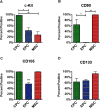Concurrent Isolation of 3 Distinct Cardiac Stem Cell Populations From a Single Human Heart Biopsy
- PMID: 28446444
- PMCID: PMC5555597
- DOI: 10.1161/CIRCRESAHA.116.310494
Concurrent Isolation of 3 Distinct Cardiac Stem Cell Populations From a Single Human Heart Biopsy
Abstract
Rationale: The relative actions and synergism between distinct myocardial-derived stem cell populations remain obscure. Ongoing debates on optimal cell population(s) for treatment of heart failure prompted implementation of a protocol for isolation of multiple stem cell populations from a single myocardial tissue sample to develop new insights for achieving myocardial regeneration.
Objective: Establish a robust cardiac stem cell isolation and culture protocol to consistently generate 3 distinct stem cell populations from a single human heart biopsy.
Methods and results: Isolation of 3 endogenous cardiac stem cell populations was performed from human heart samples routinely discarded during implantation of a left ventricular assist device. Tissue explants were mechanically minced into 1 mm3 pieces to minimize time exposure to collagenase digestion and preserve cell viability. Centrifugation removes large cardiomyocytes and tissue debris producing a single cell suspension that is sorted using magnetic-activated cell sorting technology. Initial sorting is based on tyrosine-protein kinase Kit (c-Kit) expression that enriches for 2 c-Kit+ cell populations yielding a mixture of cardiac progenitor cells and endothelial progenitor cells. Flowthrough c-Kit- mesenchymal stem cells are positively selected by surface expression of markers CD90 and CD105. After 1 week of culture, the c-Kit+ population is further enriched by selection for a CD133+ endothelial progenitor cell population. Persistence of respective cell surface markers in vitro is confirmed both by flow cytometry and immunocytochemistry.
Conclusions: Three distinct cardiac cell populations with individualized phenotypic properties consistent with cardiac progenitor cells, endothelial progenitor cells, and mesenchymal stem cells can be successfully concurrently isolated and expanded from a single tissue sample derived from human heart failure patients.
Keywords: adult stem cells; biopsy; centrifugation; endothelial progenitor cells; heart failure; mesenchymal stem cells.
© 2017 American Heart Association, Inc.
Conflict of interest statement
M. Monsanto and M. Sussman designed experiments. M. Monsanto, K. White, T. Kim, B. Wang, K. Fisher, F. Khalafalla, and S. Mohsin performed experiments and analyzed data. A. Casillas, K. Broughton, T. Kim and M. Monsanto helped in the schematic design. M. Monsanto, K. Ilves, and M. Sussman wrote the article. All authors read and approved the final article.
Figures







Comment in
-
Cardiac Cell Therapy 3.0: The Beginning of the End or the End of the Beginning?Circ Res. 2017 Jul 7;121(2):95-97. doi: 10.1161/CIRCRESAHA.117.311293. Circ Res. 2017. PMID: 28684618 Free PMC article. No abstract available.
Similar articles
-
Endogenous cardiac stem cells.Prog Cardiovasc Dis. 2007 Jul-Aug;50(1):31-48. doi: 10.1016/j.pcad.2007.03.005. Prog Cardiovasc Dis. 2007. PMID: 17631436 Review.
-
Isolation and expansion of functionally-competent cardiac progenitor cells directly from heart biopsies.J Mol Cell Cardiol. 2010 Aug;49(2):312-21. doi: 10.1016/j.yjmcc.2010.02.019. Epub 2010 Mar 4. J Mol Cell Cardiol. 2010. PMID: 20211627 Free PMC article.
-
Patient characteristics and cell source determine the number of isolated human cardiac progenitor cells.Circulation. 2009 Dec 22;120(25):2559-66. doi: 10.1161/CIRCULATIONAHA.109.849588. Epub 2009 Dec 7. Circulation. 2009. PMID: 19996019
-
Establishment of isolation and expansion protocols for human cardiac C-kit-positive progenitor cells for stem cell therapy.Transplant Proc. 2013 Jan-Feb;45(1):420-6. doi: 10.1016/j.transproceed.2012.08.017. Transplant Proc. 2013. PMID: 23375332
-
Isolation and expansion of resident cardiac progenitor cells.Expert Rev Cardiovasc Ther. 2007 Jan;5(1):33-43. doi: 10.1586/14779072.5.1.33. Expert Rev Cardiovasc Ther. 2007. PMID: 17187455 Review.
Cited by
-
Isolation, Characterization, and Differentiation of Cardiac Stem Cells from the Adult Mouse Heart.J Vis Exp. 2019 Jan 7;(143):10.3791/58448. doi: 10.3791/58448. J Vis Exp. 2019. PMID: 30663680 Free PMC article.
-
Cardiac Cell Therapy 3.0: The Beginning of the End or the End of the Beginning?Circ Res. 2017 Jul 7;121(2):95-97. doi: 10.1161/CIRCRESAHA.117.311293. Circ Res. 2017. PMID: 28684618 Free PMC article. No abstract available.
-
Enhancing myocardial repair with CardioClusters.Nat Commun. 2020 Aug 7;11(1):3955. doi: 10.1038/s41467-020-17742-z. Nat Commun. 2020. PMID: 32769998 Free PMC article.
-
Bioactive Lipid Signaling in Cardiovascular Disease, Development, and Regeneration.Cells. 2020 Jun 3;9(6):1391. doi: 10.3390/cells9061391. Cells. 2020. PMID: 32503253 Free PMC article. Review.
-
Safety profiling of genetically engineered Pim-1 kinase overexpression for oncogenicity risk in human c-kit+ cardiac interstitial cells.Gene Ther. 2019 Aug;26(7-8):324-337. doi: 10.1038/s41434-019-0084-5. Epub 2019 Jun 25. Gene Ther. 2019. PMID: 31239537
References
-
- Assmus B, Schachinger V, Teupe C, Britten M, Lehmann R, Dobert N, Grunwald F, Aicher A, Urbich C, Martin H, Hoelzer D, Dimmeler S, Zeiher AM. Transplantation of Progenitor Cells and Regeneration Enhancement in Acute Myocardial Infarction (TOPCARE-AMI) Circulation. 2002;106:3009–17. - PubMed
-
- Clifford DM, Fisher SA, Brunskill SJ, Doree C, Mathur A, Watt S, Martin-Rendon E. Stem cell treatment for acute myocardial infarction. Cochrane Database Syst Rev. 2012:CD006536. - PubMed
MeSH terms
Grants and funding
LinkOut - more resources
Full Text Sources
Other Literature Sources
Research Materials

